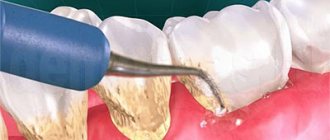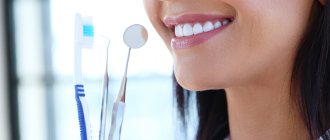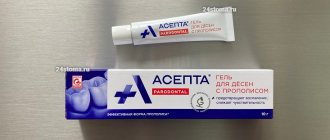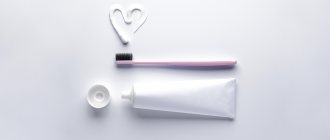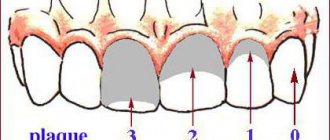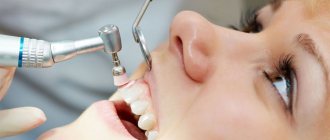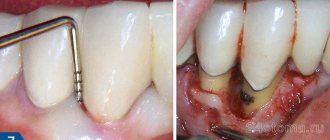Date of publication: 09/29/2018
Plaque is the worst enemy to oral health. It is he, or rather, the microbes that develop in him, that provoke the development of caries. The soft plaque becomes hard over time, turning into tartar.
It is the leading cause of gingivitis, periodontitis, gum pockets, and even tooth loss.
Plaque removal is necessary to keep teeth and gums healthy.
Why do you need to brush your teeth?
Oral hygiene is not only a matter of aesthetics. It is due to medical reasons. A plaque constantly forms on the enamel, consisting of: • food particles; • saliva; • waste products of microorganisms inhabiting the oral cavity.
The process of plaque deposition does not depend on whether a person ate in the interval between brushings. If it is not removed, over time it turns to stone. Contamination not only creates a cosmetic defect. Deposits contribute to the violation of the integrity of the enamel. Pathogenic bacteria penetrate into the resulting cracks and actively multiply under conditions of poor hygiene. This is how caries begins with all the known consequences. These microorganisms also attack the gums. In people who neglect to brush their teeth, gingivitis becomes chronic. If the inflammation is not treated, complications in the form of periodontitis and periodontal disease are possible. As a result, the root no longer holds in the socket and the tooth falls out.
Consequences of neglecting hygiene rules
Failure to comply with the rules of oral hygiene, at best, will lead to bad breath and the development of caries. But, as medical practice has shown, such neglect will have more serious consequences.
A large accumulation of harmful bacteria in the absence of hygiene procedures or their improper implementation contributes to the development of the following pathologies:
- Gingivitis. This is an inflammatory process of the gums that affects the alveolar process of the jaw. The pathology is accompanied by putrid breath, bleeding gums when brushing teeth individually, itching and a negative perception of the taste of food.
- Candidiasis. This inflammatory process develops when Candida bacteria enter the mouth. In pathology, swelling of the oropharynx and a white coating on the tongue are observed. In an advanced form of the disease, erosions may appear on the surface of the oral mucosa.
- Periodontitis. This pathology affects periodontal tissue. Symptoms of periodontitis include the formation of hard stone, tooth mobility, and the presence of purulent or serous discharge.
- Stomatitis. Such damage to the lining of the mouth occurs due to the proliferation of infectious microorganisms. When bacteria enter the human body, they destroy the surface structure of the gums, tongue and cheeks. Subsequently, ulcers appear on the affected areas.
As you can see, each pathology develops due to the entry of harmful bacteria into the oral cavity, where there is an optimal habitat for their growth and reproduction. Only careful daily oral care can correct this phenomenon.
Category Miscellaneous Published by Mister dentist
How to brush your teeth correctly?
It is a mistaken idea that everyone can do this. There are a number of rules, many of which are either unknown or ignored. However, only compliance with them guarantees effective cleaning of the enamel: • Carrying out hygiene procedures not only at home, but also at the dentist. • Rational selection of brushes and paste. • Using the optimal teeth brushing method. • Using dental floss, brushes and mouthwash. • Taking into account the condition of the gums, the presence of braces and dentures. • Compliance with the rules for storing, cleaning and replacing brushes.
Tablets for determining plaque will help you understand whether you have achieved your goal. They demonstrate whether unwanted deposits are present on the enamel. They also suggest which areas are not being worked through carefully enough.
How to choose a dental irrigator:
Below we list the main points that it is advisable to pay attention to when choosing an oral irrigator. Particular attention should be paid to the features of the water jet being formed (the number of pulsations, the presence of microbubble technology), as well as to the pressure indicators of the water jet and the presence of smooth adjustments for changing it. In addition, a very important point is the possibility of repairs and the presence of a service center in your city.
Cleaning technology (features of water jet) –
1) The first important point is the presence of pulsations of the water jet. These pulsations are so short (in different models of irrigators this figure ranges from 1200 to 2000 micropulses per minute) that they are unnoticeable. Pulsations create micro-hydraulic shocks, which make it possible to more effectively remove food debris and soft microbial plaque (compared to a water jet without pulsations). There is no particular difference between the models of irrigators that perform 1200, 1400 or 1800 jet pulsations. Those. in this case, “more” does not mean “better.”
2) The second important point is the pressure of the water jet (measured in kPa), i.e. her pressure. The optimal indicator is 500-550 kPa, but there are also more powerful models of irrigators that produce water jet pressure even up to 870 kPa. This can hardly be called a competitive advantage, because... using such pressure is already quite painful for the gums. And patients, even with healthy gums, are unlikely to be comfortable using an irrigator with such a strong jet pressure.
3) The third important point is the ability to regulate the pressure of the water jet. Moreover, it is necessary to have a smooth adjustment, i.e. selection from at least 4-5 preset levels. Reviews of dental irrigators very much depend, among other things, on the availability of smooth adjustments to the water pressure. It is optimal that the minimum level corresponds to a pressure of about 70 kPa, because You will have to start using the irrigator with a small pressure, gradually (from time to time) increasing it.
The fact is that the standard water jet pressure of 500 kPa will be quite painful if you are just starting to use the irrigator. At the same time, lower water pressure will also allow the irrigator to be used not only by adults, but also by children, as well as people with sore gums. But strong pressure can, on the contrary, only increase bleeding of the gums. In addition, the presence of levels with low pressure of the water jet (and with a special nasal nozzle) will allow the irrigator to be used for rinsing the nasal passages with a weak saline solution, for example, in patients with rhinitis or sinusitis.
4) The fourth important point is the presence of microbubble technology. This is an advanced technology developed by , but lesser-known companies have now begun to use it. This technology allows mixing of water flow and air bubbles, i.e. air aeration occurs (air content in water reaches 5%). As a result, the water stream will contain a large number of microbubbles, which will allow us to achieve two important things.
Firstly, when microbubbles explode, they also create microhydraulic shocks, which contribute to even more effective removal of food debris and plaque. And secondly, air microbubbles saturate the water with oxygen, which has a bactericidal effect on pathogenic microflora. This is especially important for patients with gum disease, such as gingivitis or periodontitis.
5) The fifth feature is the presence of different modes. Most irrigators have only 1 operating mode in the form of a pulsating monojet, but some models have additional modes. For example, in the Oral-b OxyJet irrigator, in addition to the standard mode, there is also a “turbo flow” mode. When you select the “turbo flow” mode, the built-in mini-turbine in the nozzle is activated, which begins to spin at a speed of 8000 rpm. As a result, a spiral-shaped jet stream is formed, which is optimal for gum massage.
Conclusions: we hope that now it is clearer to you which is the best oral irrigator to choose. Of course, there should be a jet pulsation of at least 1200 pulses per minute, as well as smooth adjustments of the jet pressure - from 70 kPa (some models even from 35 kPa) to approximately 500-650 kPa. Well, the presence of microbubble technology is very desirable. Below we will tell you what else you should pay attention to if you decide to buy an irrigator for your teeth and oral cavity.
Types of attachments for irrigators –
Some irrigators have universal nozzles, others have whole sets of nozzles for all kinds of cases. In addition to universal ones, there are attachments for cleaning the tongue, for washing periodontal pockets, attachments for cleaning orthodontic structures (braces), attachments for cleaning artificial crowns and bridges, and attachments for cleaning implants.
Also, some models have special nasal nozzles that allow you to rinse the nasal cavity with an irrigator, which is sometimes necessary in the treatment of rhinitis (including allergic origin) and sinusitis. Most manufacturers produce attachments that have different color indicators. This is very convenient, because... Each family member will have a nozzle of its own color, and will never confuse it with other people's nozzles.
Examples of nozzles –
Availability of a service center in your city –
Those who want to buy an oral irrigator online may encounter a lack of a service center. For example, service stations are only available in the largest cities, and to replace a defective irrigator you will need to send it by mail at your own expense. But this option is only possible during the warranty period.
Possibility of service after the warranty period expires –
Reviews of oral irrigators are often negative precisely because many cheap models are not repairable. It’s not scary if a defect is discovered during the warranty period (in this case, the broken device is simply replaced with a new one), and in this case you will only have to spend money on postage costs to send the faulty irrigator to the seller.
But if the irrigator breaks down after the warranty period has expired, then the non-repairable model can be immediately thrown away, because the service will simply refuse to repair you. You should pay close attention to this point, because... Power surges and too hard water (both of which are the norm for Russia) can affect the operation of the device.
Choosing a toothbrush
To completely clean the enamel from plaque, you need to choose a suitable brush. The easiest way to do this is by material. There are two options here - natural and synthetic. It is better to give preference to the latter, since they are quite elastic, and the tips of the hairs are usually rounded, which is safer for the gums. Bacteria multiply faster on natural materials.
In terms of the stiffness of the bristles, toothbrushes are: • Soft. They are best taken for children, adolescents and people suffering from gingivitis. • Average. A universal option for people without dental problems. • Tough. They help fight hard plaque and can be used only when indicated.
The configuration of the bristles should be discussed with your dentist. It will tell you where more sediment collects. For example, if you need to better work on the necks of teeth, bristles collected in bunches can handle this.
Pasta selection
Pastes are hygienic, preventive and therapeutic. The first ones solve the only problem - clean the enamel. The latter, due to the antiseptic component, help prevent the development of gingivitis and caries. Still others are prescribed by dentists for therapeutic purposes; it is better not to use them on your own.
Toothpastes are also distinguished according to the results of use: • whitening - slightly lighten the enamel, but you should not expect drastic changes from them; • strengthening – contain fluoride, good for enamel health; • desensitizing - reduce sensitivity; • anti-inflammatory - help with gingivitis.
Abrasiveness characterizes the degree of impact on plaque. The average value of this indicator is from 50 to 80. Higher values can be taken occasionally to lighten teeth. Lower abrasiveness is indicated for sensitive enamel and gums.
Proper brushing of teeth: sequence of movements
For hygiene purposes, you need to accustom yourself to a certain sequence of movements.
After squeezing the paste onto the brush, you must: • apply it to the teeth at an angle of 45 or 90 degrees; • pass each one 3-4 times in the direction from the gums to the cutting edge; • treat chewing surfaces with circular movements; • Allow at least 30 seconds of brushing for each half of the jaw. Depending on the location of the brush and the direction of movement, there are three methods of brushing teeth. The most famous (90 degree brush, top to bottom movements) is the Leonard method.
The Bass method involves choosing an angle of 45 degrees and making vibrating movements. It is good because the bristles penetrate into the interdental spaces and partially work out the contact surfaces. With the Fones method, an angle of 90 degrees is taken and the brush moves in a circle. This further massages the gums, which improves blood circulation and protects against inflammatory processes.
Additional oral cleansing
Oral hygiene is not limited to two rows of teeth. For complete cleansing it is necessary to treat: • Interdental spaces. Dental floss or a brush will help remove plaque. • Language. To do this, use the relief surface of the back of the toothbrush or a special scraper. • Gums. They are partly cleaned with a brush: at an angle of 45 degrees, the bristles approach the edge and capture deposits. Rinse aid also helps. • Cheeks. You can go over them with the back of the brush, but they require more rinsing.
You need to start by removing the largest food debris. To do this, just rinse your mouth with water. Then comes the turn of fragments stuck in the interdental spaces - this is where floss comes to the rescue. Now you can take up the brush with the paste. Rinse aid is used last - to create a protective layer.
Oral care after professional teeth cleaning
During the first 24 hours after professional teeth cleaning, patients are not recommended to eat foods with pronounced coloring components. It is advisable to give up strong coffee, tea and smoking. Also, during the appointment, the dentist must apply special products to prevent the formation of deposits and strengthen the enamel.
After eating, you need to brush your teeth or at least rinse your mouth with water, eat an apple or chew gum. Today there are a large number of toothpastes that actively prevent the formation of any deposits. It is advisable to have them recommended to you by your dentist.
All this will help not only avoid the formation of tartar, but also prevent many diseases of the periodontium and hard dental tissues.
How to brush your teeth with gingivitis?
Inflammation of soft tissues is not a reason to neglect hygiene. On the contrary, the more often cleansing is done, the less chance bacteria have to support the inflammatory process.
However, you need to take precautions: • choose brushes with soft bristles (preferably rounded); • choose a paste with low abrasiveness and containing medicinal herbs; • give preference to the Bass method, and abstain from the Fones method until remission; • move your hand more carefully to avoid painful sensations.
Cleaning time should not be shortened, even if the procedure causes discomfort. Sometimes dentists even recommend increasing it. Inflammation of the gums is accompanied by the formation of pockets. Where their edges lag behind, stone grows with particular intensity. This place deserves more careful study.
How to clean dental structures?
Dental structures in the mouth make adjustments to the cleaning process: • Crowns. More attention should be paid to the area where the gums come into contact with the prosthesis. • Bridges. A round mono-tuft brush is more suitable for them. • Veneers. The teeth where they are installed cannot be treated with floss. The ban does not apply to other methods. • Braces. The space under the arch and the area adjacent to the enamel is cleaned with brushes.
In all of the above cases, it is necessary to use an irrigator. Conventional cleaning devices are not able to penetrate all the places where plaque accumulates. There are no barriers for water. Under the pressure set by the device, it knocks out stuck food fragments, preventing them from decomposing or turning into stone.
How do plaque tablets work?
We usually contact a dentist to assess the quality of oral hygiene. It identifies areas that are not cleaned effectively and makes recommendations for replacing the paste or brush. But in between visits to the clinic, you can cope without the help of a doctor.
Special tablets, developed by the Swiss company CURADEN, will help with this. They are part of the CURAPROX range of dental care products. Determination of plaque occurs as follows: • the tablet is diluted in water; • after brushing, a person rinses his mouth with this solution, distributing it over his teeth; • deposits are stained, clean enamel remains intact.
The tablets also help distinguish soft plaque from tartar. The first one becomes pink, the second one becomes dark blue. This way you can understand whether it’s time to go for ultrasonic cleaning.
Why is tartar dangerous?
Such a seemingly trivial problem as plaque and tartar often remains without proper attention. Just think, not entirely aesthetically pleasing. Your teeth don’t hurt, which means there’s nothing to treat. But this is for the time being.
Microorganisms living in dental deposits multiply quickly and in the process of vital activity they release acids that spoil the enamel and lead to inflammation of periodontal tissues. Itching, swelling, bleeding, pain in the gums, increased sensitivity of enamel, halitosis (bad breath), caries are the deplorable results of an indifferent attitude towards one’s health. But all this can be avoided if you clean your teeth from tartar in a timely manner.
For many, removing stones from teeth using improvised means seems obvious and easily accessible, especially now, when there is a lot of useful advice on the Internet for any problem. But the most dangerous thing in all this is that these recommendations are given by people who do not even have a basic medical education. These methods of cleaning tartar are, of course, absurd.
Let us present two folk remedies against tartar and explain from a medical point of view why they are ineffective.
Recipe one
Grate the black radish and add lemon juice to it. Brush your teeth with the resulting mixture in the morning and evening.
Doctor's explanation:
This elixir contains acid. Indeed, more than 25 years ago, before removing tartar from teeth with instruments, doctors used a special acid that softened it. But at home, even softened dental plaque cannot be removed using improvised means. But you can easily get increased sensitivity of the enamel as a complication.
Recipe two
Prepare a decoction of walnut bark. Wet your toothbrush with the broth and brush your teeth with it three times a day for 2-3 minutes.
Doctor's explanation:
Brushing your teeth 3 times a day for 2–3 minutes is a standard recommendation from dentists. But in terms of effectiveness, walnut decoction can be compared to drinking water. Try brushing your teeth without toothpaste - you will only be able to remove soft plaque. And neither a high-quality brush, nor a herbal decoction, nor even the most advertised toothpaste can cope with hard, mineralized deposits on the teeth.
From all of the above we draw a conclusion.
Consequences of not brushing your teeth properly
Proper and timely cleaning of dental plaque is protection against oral diseases.
If you neglect it, the consequences will only increase: • Tartar forms. It gives off an unpleasant odor. If you do not carry out ultrasonic cleaning, it will become a favorite place for bacteria. • Bacteria will destroy the enamel. The abundance of pathogenic microorganisms quickly leads to caries. • Bacteria will cause your gums to become inflamed. Soft tissues are no less sensitive to them than hard ones. And this means bleeding, swelling and an unpleasant odor.
Possible complications are also worth mentioning. Caries develops into pulpitis, which requires removal of the nerve. This deprives the tooth of nutrition, as a result of which it sooner or later collapses. Progressive gingivitis is fraught with periodontitis and periodontal disease. Lack of oral hygiene leads to tooth loss. Restoring them is more expensive than the cost of a brush, paste and professional cleaning. Therefore, it is better to remember these simple rules and follow them.
Carrying out professional cleaning
Oral hygiene with professional help is carried out to eliminate accumulations of soft plaque, which over time develops into tartar. When a hard stone forms, a person loses his attractive appearance. In addition, against the background of this pathology, concomitant dental diseases develop.
To prevent these negative phenomena, the dental hygienist prescribes measures using medical instruments and special equipment.
Rules for preliminary examination
Before proceeding with professional intervention, the dentist must first carefully examine the patient. Medical methods of oral hygiene depend on the following diagnostic indicators: caries intensity index, hygienic index, assessment of the condition of the mucous membrane, type of bite, and the presence of dental pathologies.
After assessing the condition of the oral cavity, the specialist must form a responsible attitude towards the prescribed procedure in the patient. It is important that a person understands that medical oral hygiene can completely get rid of periodontal disease and improve the external condition of teeth.
Carrying out procedures
A medical complex of measures to remove persistent dental tumors can be carried out therapeutically, orthodontically or surgically. Each event is conducted by a dentist in a medical office.
In order for professional oral hygiene to go smoothly, before it begins, the patient is prescribed rinsing the nasopharynx with an antiseptic solution.
For major operations, anesthetic medications may be used, in the form of sprays or injections. The professional cleaning complex includes several stages.
Elimination of plaque and tartar. An ultrasonic device is used for this. In some cases, manual mechanical cleaning with dental instruments is used.
Removing pigmented plaque. A popular device for cleaning teeth from soft plaque is the AirFlow device. As a result of the pressure of the emitted water, air and soda, the enamel becomes lighter by 2 shades.
Polishing teeth. This method uses professional products that contain zirconium microparticles.
Fluoridation. This method involves strengthening the enamel with fluoride-containing gel trays. The procedure lasts only a minute, but during this time the enamel has time to become saturated with fluoride ions, due to which it becomes stronger.
Fissure sealing. This method involves using composite resins to fill the grooves of the teeth on the chewing side using a special tool.
Many patients neglect professional procedures, as well as the visit to the dentist itself. However, this position is fundamentally wrong.
By contacting a specialist in a timely manner, you can avoid dangerous pathologies of the oral cavity, as well as receive recommendations for daily care so that individual oral hygiene brings significant benefits.

